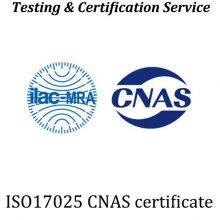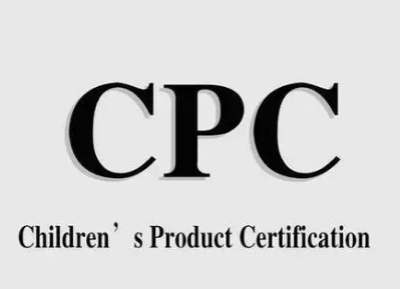Home > Products > Product Testing > Product Scope of CPC Testing, Differences Between CPC Certification and GCC Certification
Product Scope of CPC Testing, Differences Between CPC Certification and GCC Certification
- T/T L/C PayPal D/P Western Union Other
You May Like
-
CA65 Certification for Electronic Devices: Which Components of Electronic Devices Need to Be Tested?
-
What are the RoHS certification application process and standards for walkie-talkies?
-
Analysis of key points of battery testing when smart watches apply for CE and RoHS certification
-
How Electronic and Home Appliances Get High-efficiency and Environmentally Friendly Labels
-
Analysis of the Canadian IC/ISED certification process: Detailed steps for wireless products to enter the Canadian market in compliance
-
Argentina IRAM Certification Safety and Performance Testing of Solar Products
Product Description
Product Scope of CPC Testing, Differences Between CPC Certification and GCC Certification
The CPC, short for Children's Product Certificate, is a declaration of conformity document certifying that a product complies with US safety standards, particularly for products intended for children under 12 years old. It's important to note that CPC certificates are not issued by any official organization but are compiled by the company itself based on test results from a CPSC-approved third-party laboratory. Whether the certificate is compiled with laboratory assistance or independently, the company bears full legal responsibility for the authenticity and compliance of the certificate content.
I. Background and Origins of CPC Certification
1.1 Regulatory Background
CPSIA, signed and implemented in 2008: Overview of the main provisions of the US Consumer Product Safety Improvement Act (CPSIA) and its impact on children's products. CPSIA imposes strict safety requirements on children's products, including limits on lead and phthalates. It also introduces mandatory third-party testing and certification requirements.
Main provisions of the CPSIA include:
Reducing Hazardous Substance Limits: Strictly limits the content of lead and other hazardous substances in children's products.
Mandatory Third-Party Testing: Children's products must be tested by a CPSC-approved laboratory before being placed on the market.
Certification and Labeling Requirements: Manufacturers and importers must provide a Children's Product Certificate (CPC) and attach a traceability label to their products to facilitate product recalls and consumer inquiries.
The Role of the CPSC (U.S. Consumer Product Safety Commission)
CPSC's Functions: The CPSC is responsible for developing and enforcing safety standards for children's products, ensuring that all children's products meet regulatory requirements before entering the market.
1.2 Scope of Products Applicable to CPC Certification
Main Applicable Products
CPC certification applies to products designed or intended primarily for children under 12 years of age. According to CPSC regulations (see 16 CFR §1200), these products include, but are not limited to:
Toys: such as dolls, puzzles, and model cars.
Children's Furniture: such as cribs, high chairs, and children's tables and chairs.
School Supplies: such as children's books, educational cards, and drawing materials.
Manufacturers and importers must ensure that these products comply with all applicable children's product safety rules and provide the corresponding CPC certificate based on satisfactory test results from a CPSC-accredited laboratory.
II. Main Requirements for CPC Certification
CPC certification requires compliance with specific federal safety regulations and testing standards depending on the type of children's product. The following is a summary of the different testing requirements for each product type:
2.1 Toys
Physical and Mechanical Testing:
Small Parts Testing (16 CFR Part 1501): Ensures that toys do not contain small parts that can be swallowed by children under 3 years old to prevent choking hazards.
Sharp Edges and Points Testing (16 CFR Part 1500.48 and 1500.49): Inspects toys for sharp edges or points that could scratch or puncture children.
Chemical Testing:
Lead Content Testing (16 CFR Part 1303): Limits the amount of lead in toys to protect children from lead poisoning.
Phthalate Content Testing: Detects phthalate content in plastic and rubber materials to prevent potential health effects.
Flammability Testing:
Material flammability testing is performed on toys containing textiles and fillings to prevent fire risks.
2.2 Children's Furniture Products
Stability Testing:
Tip-over Testing: Ensures that baby chairs, cribs, and other items will not tip over under normal use and foreseeable abuse, preventing accidental injuries.
Mechanical Strength Testing:
Structural Integrity Testing: Verifies that furniture can withstand the stress of daily children's activities without structural failure or component loss.
Chemical Testing:
Surface Coating Lead Content Testing: Detects lead content in furniture surface coatings to ensure it does not exceed safety limits.
2.3 School Supplies
Chemical Safety Testing:
Heavy Metal Content Testing: Detects heavy metal content in products such as drawing sets and stationery to protect children's health.
Hazardous Chemical Substance Testing: Ensures that products do not contain excessive levels of hazardous substances such as phthalates.
Small Parts Testing:
Inspect stationery accessories for small parts to prevent choking hazards caused by accidental swallowing.
2.4 Electronic Toys
Electrical Safety Testing:
Electrical Toy Safety Standard (16 CFR Part 1505): Ensures that electronic toys are designed and constructed to prevent risks such as electric shock, short circuits, and overheating.
Electromagnetic Compatibility (EMC) Testing:
Ensures that electronic toys do not cause harmful electromagnetic interference to other electronic equipment and comply with relevant EMC standards.
III. CPC Certification Application Process
3.1 Detailed Description of Application Steps:
Sample Preparation: Describes how to prepare samples for each product type. Sampling requirements vary depending on the product type.
Laboratory Selection and Testing: Selecting a CPSC-approved laboratory ensures that product testing complies with the certification standards.
CPC Certificate Preparation: The CPC certificate includes product description, test standards, manufacturer information, etc.
List of Required Documents:
Product Information: Includes product name, model, and description.
Test Report: A test report issued by a CPSC-approved laboratory, detailing the test items and results.
Manufacturer and Importer Information: This includes the date of production, location, and responsible person.
IV. Contents of the CPC Certification Declaration of Conformity
4.1 Product Information
Product Description: Provide detailed information on the product's name, model, style, color, etc., ensuring accurate identification.
Product Image (Optional): For enhanced identification, you may attach an image of the product.
4.2 List of Applicable Children's Product Safety Rules
List of Regulations and Standards: List all applicable federal children's product safety regulations, rules, bans, or standards with which the product complies. For example:
Lead Content Standard (CPSIA Section 101)
Phthalates Limit (CPSIA Section 108)
Toy Safety Standard (ASTM F963)
Other applicable 16 CFR sections
4.3 Information on the Basis of Certification
Test Basis: Describe the basis for certification, typically based on test results from a CPSC-approved third-party laboratory.
Test Report Number: List the relevant test report number for traceability.
4.4 Production Date and Location
Production Date: Provide the specific date or date range (at least to the month and year) when the product was manufactured.
Production Location: List the complete address where the product was manufactured, including the factory name, address, city, state/province, and country.
4.5 Testing Date and Location
Testing Date: Provide the specific date or date range where the product was tested.
Testing Location: List the complete address of the laboratory where the testing was conducted, including the city and country.
4.6 Certification Entity Information
Certification Entity Name and Contact Information: The company or individual responsible for issuing the CPC certificate, typically the company itself.
Company Name
Contact Name and Title
Full Physical Address
Phone Number
Email Address
4.7 Third-Party Laboratory Information
Laboratory Name and Address: List the name and complete address of the CPSC-accredited laboratory where the product was tested.
Laboratory Contact Information: Include the contact name, phone number, and email address for easy communication.
4.8 Certificate Signature
Signatory Name and Title: List the name and title of the authorized representative of the company responsible for certification.
Signature and Date: The certificate should be signed by the authorized representative and dated.
4.9 Other Required Information
Certificate Number (optional): For internal management and tracking purposes, a unique certificate number or reference number may be included.
Statement: A formal statement confirming that the product complies with all applicable federal safety regulations listed.
V. Comparison between CPC and GCC Certifications
5.1 Scope of Application
CPC (Children's Product Certificate): Applicable to products intended for children under 12 years of age, i.e., children's products.
GCC (General Certificate of Conformity):
Applicable to general consumer products, i.e., non-children's products.
This includes adult products, household appliances, general furniture, etc.
Contact Us

- SHENZHEN LCS COMPLIANCE TESTING LABORATORY LTD.
- Contact nameleo tu Chat Now
- Address1&2/F, Building A, Juji Industrial Park, Yabianxuezhiwei, Shajing Street, Bao'an District, Shenzhen, Guangdong, China, Shenzhen, Guangdong
Product Categories
New Products
-
Children's toys exported to Europe need EN71 certification? The latest standards!
-
EU PED Directive: 2014/68/EU (PED) EC Type
-
?The CCC certification model for mobile power supplies, lithium-ion batteries and battery packs has been adjusted
-
UK ROHS Certification Regulation Requirements
-
Safety of household and similar electrical appliances - Particular requirements for kitchen machines IEC 60335-2-14 Update
-
Cross-border e-commerce tips | CPC certificate for children's products in the United States
-
Profile test in Bluetooth BQB certification
-
CCC certification master four steps and three points to pay attention to, CCC certification problems can be easily solved!
-
EU Certification | EN 18031 RED Cybersecurity
-
Taiwan NCC Certification (RF, SAR, Telecom)
-
Taiwan BSMI Certification (Safety & EMC & ROHS)
-
Australian RCM Certification/RCM Registration/RCM Logo
-
Wi-Fi Alliance Certification/Wi-Fi Certification Classification
-
FCC ID Certification for Bluetooth Headphones
-
GCC Certification: Attention, companies exporting toys and electrical appliances! A must-have for exporting to the Middle East
-
Interpretation of GB 6675-2014 Foreseeable and Reasonable Misuse of Toys
-
Interpretation of the Withstand Voltage Test in IEC 60335-1:2020
-
Which countries require COC certification?
Popular Searches
- Lipo Battery
- Outdoor Led Street Light
- Push Switch
- tea maker
- stainless steel cookware
- stainless steel kettle
- induction cooker
- Led Street Lighting
- Led Street Light
- lab testing
- Oil Immersed Transformer
- Air To Water Heatpump
- water jug
- plastic pot
- Led Solar Street Light
- circuit breaker mccb
- Box Fan
- testing
- cordless electric kettle
- stainless steel ware
- stainless steel tea kettle
- ul certification
- gs certification
- cb testing
- cb mark
- lighting ce certification
- Cb Circuit Breaker
Recommended Products
- What are the RoHS certification application process and standards for walkie-talkies?
- CA65 Certification for Electronic Devices: Which Components of Electronic Devices Need to Be Tested?
- What is TSCA certification? How do I apply for TSCA testing in the United States? Which products require TSCA certification?
- What is PFAS certification? PFAS testing requirements and standards, PFAS certification application process
- UN 38.3 Transport Testing and Certification for Lithium Batteries and Lithium Battery Packs
- CB Certification for Hair Dryers: IEC60335 Testing and Certification
- FCC ID Certification for Wireless Bluetooth Remote Controls
- Singapore PSB Certification for Rice Cookers
- Australian SAA Certification for Heaters: AS/NZS 60335.2.30 Testing Standard
- What are the EAC certification standards?
- What is SABER Certification?
- What is the FDA testing and certification process?
Find Similar Products By Category
- Service > Commercial Service > Other Commercial Service
Product Tags:
- Please Enter your Email Address
- Please enter the content for your inquiry.
We will find the most reliable suppliers for you according to your description.
Send Now-
 leo tu
Hi there! Welcome to my shop. Let me know if you have any questions.
leo tu
Hi there! Welcome to my shop. Let me know if you have any questions.
Your message has exceeded the limit.

- Contact supplier for lowest price
- Customized Request
- Request Sample
- Request Free Catalogs
Your message has exceeded the limit.
-
Purchase Quantity
-
*Sourcing Details
Your inquiry content must be between 10 to 5000 characters.
-
*Email
Please enter Your valid email address.
-
Mobile



